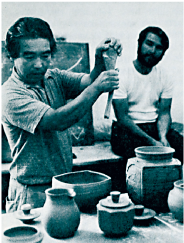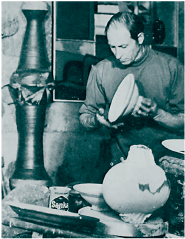Vale - Shiga Shigeo 1928-2011
With the passing of Shiga Shigeo, Australian ceramics has lost a great and long-standing friend.
There will be many tributes from those who knew him intimately, and these few words are simply to acknowledge the presence, and now the absence, of a Zen larrikin who found, at least for a time, a second home in Australia.

In any analysis of Australian ceramics the abiding influence of Japan is of great significance and in this singular and fascinating relationship between the two cultures the figure of Shiga is prominent. For all the hundreds of Australian potters who took the ‘Mashiko express’ in the 1960s and 70s, Shiga was one of the few took the journey in the other direction. First in Mittagong, then in Sydney, he inspired and delighted Australian potters for the thirteen years he spent in this country. Even after his return to Japan in 1980, Shiga maintained close contact with Australia and with the many Australian potters who revelled in his company.
There are many Japanese potters that have won the admiration of Australian potters, but few who came as close in spirit to this country as Shiga. From Tokyo to Terrey Hills and back again is a fair way, but it was the journey that Shiga made, and we are grateful that he did.
Damon Moon
Willunga 2011
Editor’s note: In our Archive section, pages 98-100, I have reprinted Shiga’s farewell speech (from Pottery in Australia, Vol 18, No 2, October November 1979) given at the opening of his retrospective exhibition at the Japan Foundation Centre in August 1978 just before he returned to Japan after thirteen years in Australia.
Vale - Paul Soldner 1921 – 2011
In early January 2011, Paul Soldner, one of the greats of American ceramics, passed away at his home in Claremont, California. He was eighty- nine.
Born in 1921 into a family of Midwest Mennonite Christians, Soldner’s interest in art was sparked by his wartime experiences in the army medical corps, where, to quote Jori Finkel writing of Soldner in the Los Angeles Times, he saw ... “beauty emerge from terror in the form of charcoal drawings made by Holocaust victims on the barracks walls of the Mauthausen concentration camp in Austria”.
(Frinkel, J. Los Angeles Times 4 January, 2011)

In 1954 Soldner became the first graduate student of Peter Voulkos in the newly established ceramics program at the Los Angeles County Art Institute. Like Voulkos, Soldner was given to experimentation and innovation and was also something of a showman, soon becoming what Garth Clark refers to ... “as one of the stars of the “workshop circuit”. (Clark, G. Shards, p.289)
It was during one of these workshops that Soldner famously ‘discovered’ his technique of ‘American raku’, where pots were drawn from the kiln and then ‘smoked’ in various ways to produce a range of effects much broader than those found in the original Japanese technique. But Soldner’s oeuvre extended well beyond this, encompassing a wide range of ceramic techniques and forms.
Paul Soldner was a charismatic teacher and tireless maker who came to prominence at a time and in a place when ceramics was breaking many boundaries. He continued to contribute to the development of ceramics both in the United States and on an international level throughout a long and productive life, and he will be both celebrated and missed.
Damon Moon
Willunga 2011
